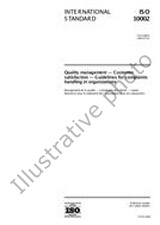We need your consent to use the individual data so that you can see information about your interests, among other things. Click "OK" to give your consent.

ISO/TR 12470-2:2017
Fire-resistance tests — Guidance on the application and extension of results from tests conducted on fire containment assemblies and products — Part 2: Non-loadbearing elements
Translate name
STANDARD published on 23.11.2017
The information about the standard:
Designation standards: ISO/TR 12470-2:2017
Publication date standards: 23.11.2017
SKU: NS-802367
The number of pages: 69
Approximate weight : 207 g (0.46 lbs)
Country: International technical standard
Category: Technical standards ISO
The category - similar standards:
Fire-resistance of building materials and elementsIgnitability and burning behaviour of materials and products
Annotation of standard text ISO/TR 12470-2:2017 :
Description / Abstract: ISO/TR 12470-2:2017 explains a methodology to determine the applicability of the results of fire resistance tests to actual applications. ISO/TR 12470-2:2017 is applicable to those non-loadbearing elements for which there is an ISO standard test procedure based upon the ISO 834 series for determining the fire resistance of a representative sample of the construction proposed for use in a specific building or just for general use. These elements are: - fire resisting door assemblies (excluding lift landing doorsets): - timber; - steel; - fire resisting vertical glazing ? metal framed: NOTE The rheology of glass is such that gravity has a disproportional influence on fire glass when it is heated to high temperatures and as a consequence, it is not possible to provide generic guidance on the extended application of horizontal glazed elements. - timber framed; - linear gap sealing; - service penetration sealing. Fire resistance testing furnaces have fairly restricted size limitations and as a consequence, there is little confidence that the result obtained on an element of construction tested in accordance with the standard methods will behave in a similar manner when installed in the final building. Direct and extended applications of test results are the two possible ways to ensure that an element that is not identical to the tested construction will have an acceptable probability of obtaining the same fire rating as that of the original tested specimen. In both cases, these applications generally refer only to the fire rating that the building element can expect to reach if it, or a representative sample of it, were to be tested in a furnace according to the standard fire test conditions used in the reference test. The criteria and methodology used in evaluating ductwork and dampers is significantly different from those used to evaluate conventional separating elements and for this reason, these forms of construction are not included in the scope of this document. It is planned that a subsequent part of this document may include guidance on these elements.


 Cookies
Cookies
